Electric vehicle (EV) sales continue to grow in Australia and the choice of vehicles in the SUV category has grown considerably.
With that many more electric SUVs arriving on our shores, combined with West Aussie’s love of anything SUV, there's even more reason to start considering an electric future.
So, here’s an update of the electric SUVs available in Australia right now, as well as others arriving throughout the year. We've broken the list down into small, medium and large electric SUVs.
Production delays may push these timings out (and prices ever upward), but here’s what we know for now.
For other electric vehicle categories, see Small EV sedans, Mid-size EV sedans, Large EV sedans, EV utes and EV vans.
Skip to Mid-sized electric SUVs »
Skip to Large electric SUVs »
SMALL SUVs
MG ZS EV from $48,990 driveaway
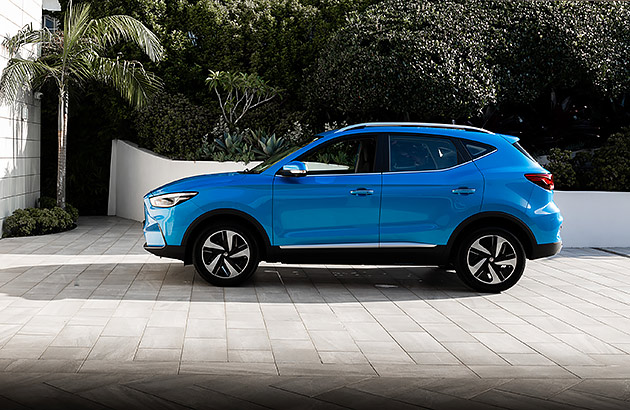
The MG ZS EV from China remains one of Australia’s cheapest EVs.
It received a boost in 2023 with the arrival of a new long-range version, naturally called the Long Range (LR). It adds a 72kWh battery offering a handy 440km of range. This compares to 320km for the continuing 50.3kWh Standard Range (SR) version.
But the LR is also roughly 25 per cent more expensive.
To charge the latter with a 50kW DC public charger from 10 to 80 per cent, you’ll need about 70 minutes (SR: 62min), while a 7kW Wallbox at home/work needs about 12 hours to reach 100 per cent full (SR: 9hr), as opposed to nearly 40 hours using a normal household plug (SR: 25hr).
Both ZS EVs are roomy and well equipped, and offer reasonable performance from a 130kW electric motor. But while the MG corners precisely, the suspension can feel jittery and there’s not much refinement.
| Motor: | Synchronous electric permanent-magnet |
|---|---|
| Transmission/drive: | Single-speed reduction gear/FWD |
| Battery: | 51kWh and 72kWh Lithium Iron Phosphate |
| Power/torque: | 130kW/280Nm |
| 0-100km/h: | 8.6s (LR: 8.4s) |
| Consumption: | 17.3kWh/100km (LR: 17.8) |
| Electric range: | 320km |
| Warranty: | 5yr/unlimited km |
| Battery warranty: | 7yr/unlimited km |
| Safety rating: | 5 stars |
BYD Atto 3 from $48,011
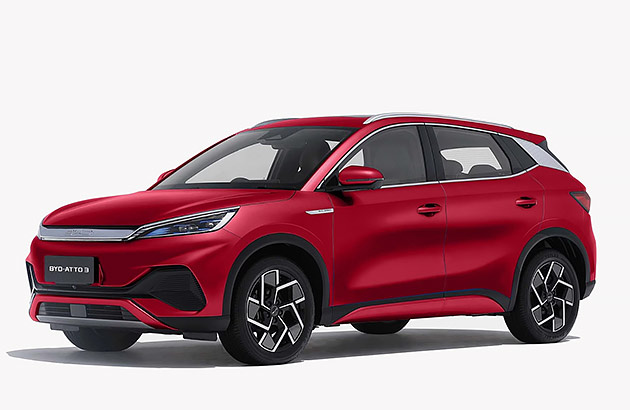
BYD – for Build Your Dreams – is a Chinese car company created in 2003, with the Atto 3 its first big hit.
Like the MG ZS, the BYD is a small SUV offering a high-riding five-seater bodystyle. It also features a futuristically-designed dashboard, plenty of space and decent equipment levels, including a long list of driver-assist safety gear.
Built on a dedicated EV platform, the Atto 3 employs a 150kW electric motor and front-wheel drive. The Standard Range’s 50.1kWh battery offers 320km of range while the Superior Range boasts a 60.4kWh unit for a range of 420km.
Using a 50kW DC charger, a 10 to 80 per cent top-up needs about 55 minutes, or about 10 hours for a 100 per cent fill with an optional 7kW Wallbox. Plugging in at home will take around 31 hours.
| Motor: | Synchronous electric permanent-magnet |
|---|---|
| Transmission/drive: | Single-speed reduction gear/FWD |
| Battery: | 50.1/60.4kWh Lithium Iron Phosphate |
| Power/torque: | 150kW/310Nm |
| 0-100km/h: | 7.3s |
| Consumption: | 14.4-15.7kWh/100km |
| Electric range: | 320/420km |
| Warranty: | 7yr/unlimited km |
| Battery warranty: | 7yr/160,000km |
| Safety rating: | 5 stars |
Hyundai Kona Electric from $55,000 (estimated)
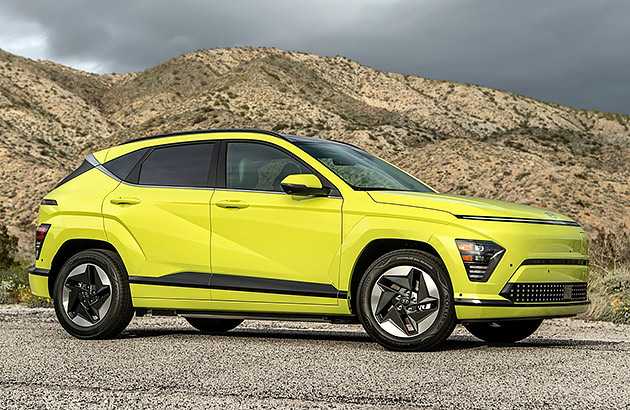
The original Kona was a very compact SUV; its eye-catching successor – due later in 2023 – is larger and roomier, as well as more practical.
Being related to the latest Kia Niro means the Kona II Electric isn’t as advanced as Hyundai’s acclaimed Ioniq 5/6 models, but nor is it as expensive, either.
The 114kW Standard Range (SR) features a 48.4kWh battery with a 342km range, while the 160kW Long Range (LR) gains a 65.4kWh battery for up to 490km between top-ups.
Speaking of which, with the LR, a 10 to 80 per cent refill using a 50kW DC fast charger requires about 75 minutes, 11 hours with an optional 7kW Wallbox or about 34 hours plugged in at home. Deduct about 25 per cent for the SR.
A ‘Vehicle-2-Load’ facility means owners can also power electrical appliances if required, further highlighting the Kona’s newfound functionality. It should prove very popular.
| Motor: | Synchronous electric permanent-magnet |
|---|---|
| Transmission/drive: | Single-speed reduction gear/FWD |
| Battery: | 48.4kWh/65.4kWh Lithium Ion |
| Power/torque: | 114kW/255Nm or 160kW/255Nm |
| 0-100km/h: | 10.0s/8.0s |
| Consumption: | 16.0kWh/100km (estimated) |
| Electric range: | 342/490km |
| Warranty: | 5yr/unlimited km |
| Battery warranty: | 8yr/160,000km |
| Safety rating: | N/A |
Peugeot e-2008 from $59,990
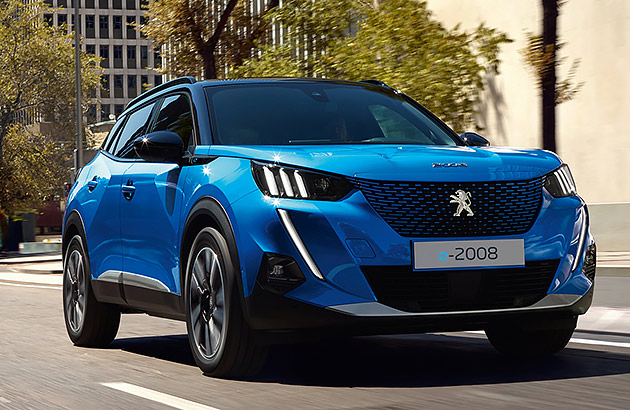
Peugeot’s first EV for Australia is also one of Europe’s bestsellers, having been available there since 2021.
The e-2008 is based on the brand’s stylish petrol-powered 2008 small SUV, with its crisp lines and progressive and surprisingly upmarket interior presentation, and aims to steal sales from more-expensive luxury EV crossovers like the Mercedes EQA and BMW iX1.
Under the bonnet is a 100kW electric motor, driving the front wheels, with a modest 50kW battery providing a maximum 328km of range. This is a city-focused Euro SUV, after all.
Topping that battery up from 10-80 per cent using a 50kW DC public charger only needs about 45 minutes, or roughly eight hours to 100 per cent with an optional 7kW Wallbox and about 24 hours via a household plug.
Later in 2024 the e-2008 facelift is coming, with more power and usefully more range, but it will probably cost a lot more, too.
| Motor: | Synchronous electric permanent-magnet |
|---|---|
| Transmission/drive: | Single-speed reduction gear/FWD |
| Battery: | 50kWh Lithium Ion |
| Power/torque: | 100kW/260Nm |
| 0-100km/h: | 8.5s |
| Consumption: | 15.7 kWh/100km |
| Electric range: | 328km |
| Warranty: | 5yr/unlimited km |
| Battery warranty: | 8yr/160,000km |
| Safety rating: | 5 stars |
Kia Niro Plus PBV EV from $64,450
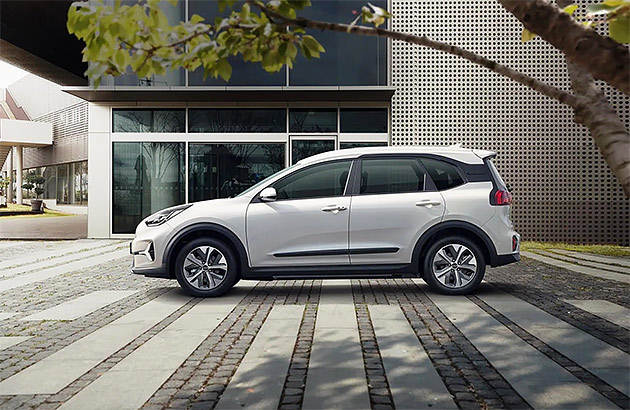
Short for ‘purpose-built vehicle’, the Niro Plus PBV is the previous-shape Niro hatchback, but with a longer and taller body and substantially more space inside.
Aimed at the fleet market more so than private buyers, the seats are smaller to maximise interior space, while extra grab handles are fitted to aid entry/egress. There is also a hybrid version specifically targeting taxi operators.
Under the EV’s bonnet is a 150kW/395Nm electric motor, driving the front wheels, while a substantial 64kWh battery can provide up to 455km of range.
Broadly speaking, using a 50kW DC charger, the Niro Plus needs about 70 minutes for a 10 to 80 per cent top-up, or about 12 hours with an optional 7kW Wallbox. Plugging in at home will take around 35 hours.
As a wagon/commercial EV proposition, the Niro Plus is unique in the market. It’s also the first of a several PBVs Kia is planning in the future.
| Motor: | Synchronous electric permanent-magnet |
|---|---|
| Transmission/drive: | Single-speed reduction gear/FWD |
| Battery: | 64kWh Lithium Ion |
| Power/torque: | 150kW/395Nm |
| 0-100km/h: | 8.5 seconds (estimated) |
| Consumption: | 18.0kWh/100km (estimated) |
| Electric range: | 455km |
| Warranty: | 7yr/unlimited km |
| Battery warranty: | 8yr/160,000km |
| Safety rating: | N/A |
Kia Niro II EV from $65,300
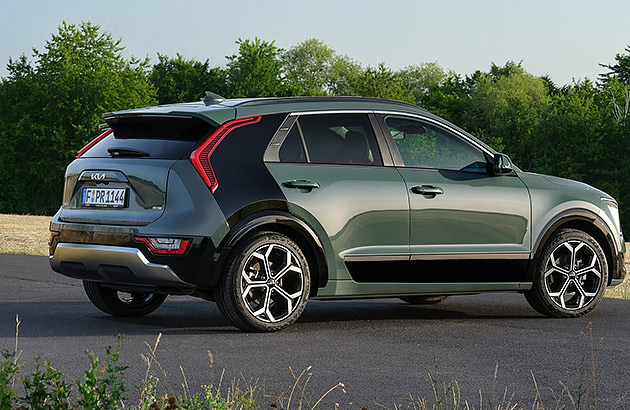
Twinned with the all-new Hyundai Kona II, the Niro II builds on its homely predecessor’s family-friendly crossover shape with more space and practicality, as well as a far-more modern dash, with a massive touchscreen look.
The Kia will again be available in hybrid and plug-in hybrid guises, meaning it doesn’t employ the Hyundai Group’s vaunted new E-GMP EV architecture, but an updated “EV-first” version of the old platform.
As before, a 150kW electric motor drives the front wheels. Range is an impressive 463km.
Plugging the Kia into a household socket it takes nearly 34 hours to replenish the 64.8kWh battery; an optional 7kW Wallbox will slash that to about 11 hours, while a 50kW DC public fast charger will take it from 10 to 80 per cent full in around 70 minutes.
Easy, spacious and comfortable, but now with fresher styling, more advanced driver-assist safety and improved efficiency, the Niro EV deserves a long, hard look.
| Motor: | Synchronous electric permanent-magnet |
|---|---|
| Transmission/drive: | Single-speed reduction gear/FWD |
| Battery: | 64.8kWh Lithium Ion |
| Power/torque: | 150kW/255Nm |
| 0-100km/h: | 7.8s |
| Consumption: | 16.4kWh/100km |
| Electric range: | 463km |
| Warranty: | 7yr/unlimited km |
| Battery warranty: | 8yr/160,000km |
| Safety rating: | 5 stars |
Mazda MX-30 EV from $66,010
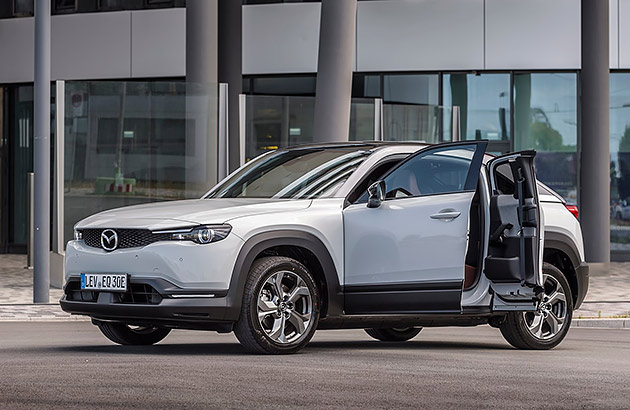
Yes, there’s a mild-hybrid petrol MX-30; but the EV version is more notable as Mazda’s first electric car in Australia.
Related to the hugely-popular CX-30, the MX-30 is a coupe/SUV aimed at buyers prioritising style over practicality. Hence the fiddly rear-hinged rear doors and smallish boot.
It also departs from the EV norm by having a smaller and lighter battery – its 35.5kWh unit is half the size of the Hyundai Ioniq 5’s, for instance. Why? Faster to charge, nimbler to drive, and easier on earth’s resources. Makes sense.
An optional 7kW Wallbox charger will have the MX-30 recharged in 5.5 hours, while a regular household socket needs just 15.5 hours. On the flipside, range maxes out at just 200km. That, Mazda argues, is more than sufficient for most daily commutes.
The MX-30’s five-seater interior is lovely to behold, well-equipped and quite roomy. It isn’t fast, but the Mazda is quiet, comfortable and relaxed.
| Motor: | Synchronous electric permanent-magnet |
|---|---|
| Transmission/drive: | Single-speed reduction gear/FWD |
| Battery: | 35.5kWh Lithium Ion |
| Power/torque: | 107kW/271Nm |
| 0-100km/h: | 9.7s |
| Consumption: | 17.9kWh/100km |
| Electric range: | 200km |
| Warranty: | 5yr/unlimited km |
| Battery warranty: | 8yr/160,000km |
| Safety rating: | 5 stars |
Volkswagen ID.4 from $70,000 (estimated)
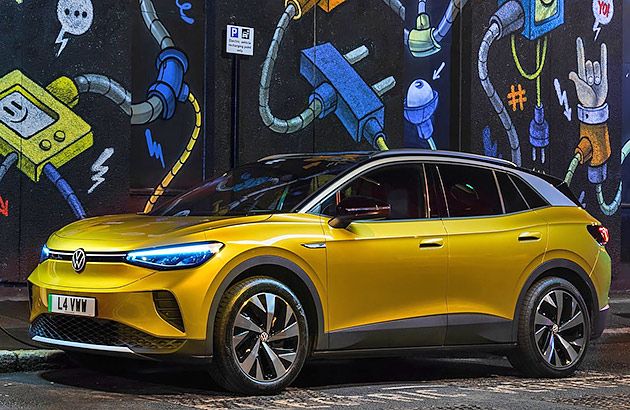
Expected by early 2024, the VW ID.4 is a medium-sized crossover/SUV to rival the Toyota bZX4.
The brand’s first EV in Australia, sat on a dedicated EV platform, it is a solid if conservative design inside and out, but with plenty of space and lots of practicality.
We’re anticipating a 125kW rear-mounted motor version driving the rear wheels, and motivated by a 55kWh battery for a 345km range. There’s also a 150kW model that’s powered by an 82kWh battery for a range of 522km.
Whether we see the dual-motor models with all-wheel drive remains to be seen.
With the 55kWh battery, a 50kW DC charger means a 10 to 80 per cent wait time of about 60 minutes (82kWh battery: 75min), nine hours with an optional 7kW Wallbox (82kWh: 12hr) and about 27 hours using in household socket (82kWh: 40hr).
Said to be unexciting but competent to drive, the ID.4 should be a sensible option.
| Motor: | Synchronous electric permanent-magnet |
|---|---|
| Transmission/drive: | Single-speed reduction gear/RWD |
| Battery: | 55kWh and 82kWh Lithium Ion |
| Power/torque: | 125kW/310Nm and 150kW/310Nmm |
| 0-100km/h: | 9.0s and 8.5s |
| Consumption: | 16.7 and 17.2kWh/100km |
| Electric range: | 345km and 522km |
| Warranty: | 5yr/unlimited km |
| Battery warranty: | 8yr/160,000km |
| Safety rating: | 5 stars |
Volvo XC40 Recharge from $76,990
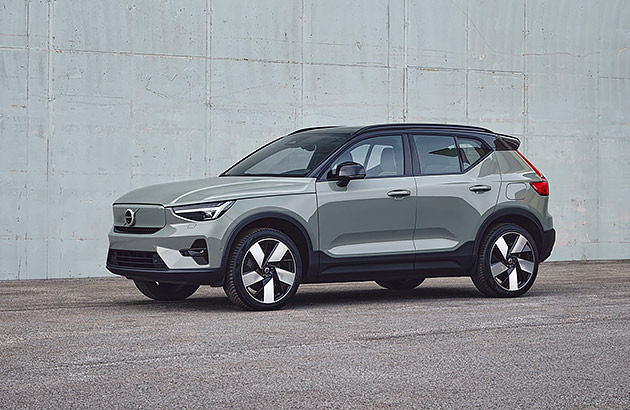
Volvo’s first EV, the XC40 Recharge, sees big changes for 2024.
The Chinese-built Swedish small SUV has switched from front-drive to rear-drive, while gaining faster charging capability and a bigger battery option.
In Single Motor models, a revised 175kW motor powered by an updated 69kWh battery drives the rear wheels, bumping up range by 10 per cent. There’s also a new 82kWh ‘Extended Range’ (ER) battery option, bringing with it a 185kW motor.
Need extra traction? The Twin Motor models adopt the 82kWh ER battery but ditch the old 150kW motors on each axle for a 183kW unit out back and fresh 117kW asynchronous motor up front.
A 50kW DC public outlet will charge either battery sizes from 10-80 per cent in about 70 minutes, or to 100 per cent in 11 hours with an optional 7kW Wallbox and 34hr using a household plug (ER is 13hr and 41hr respectively).
Solid and sensible, the XC40 Recharge is roomy, practical and comfortable.
| Motor: | Synchronous electric permanent-magnet |
|---|---|
| Transmission/drive: | Single-speed reduction gear/RWD or AWD |
| Battery: | 69kWh, 82kWh (ER), Lithium Ion |
| Power/torque: | 175kW/420Nm, 185kW/420Nm, 300kW/670Nm |
| 0-100km/h: | 7.3s, 7.3s, 4.8s |
| Consumption: | 16.8, 16.7, 17.7kWh/100km |
| Electric range: | 460km, 515km, 500km |
| Warranty: | 5yr/unlimited km |
| Battery warranty: | 8yr/160,000km |
| Safety rating: | 5 stars |
Volvo C40 Recharge Pure Electric from $78,990
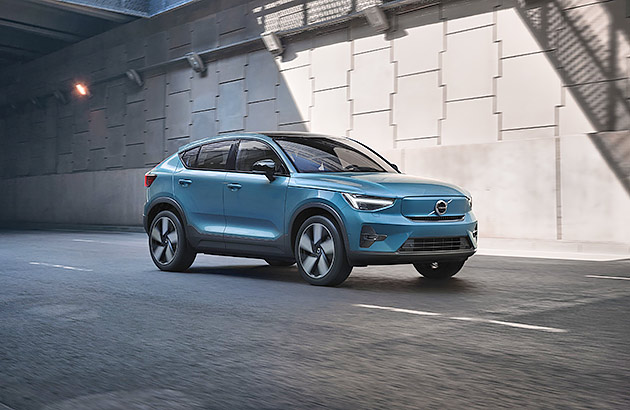
Essentially a coupe version of the boxy XC40 SUV, the stylish C40 is the first EV-only Volvo model.
In 2023, the Chinese-made Swede went from front-drive to rear-drive, while gaining improved efficiency, faster charging and an extended range (ER) battery option.
In Single Motor models, a revised 175kW motor powered by an updated 69kWh battery drives the rear wheels, for a 10 per cent range improvement. Plus, a new ER 82kWh battery option arrives, along with a 185kW motor.
The Twin Motor also goes ER, while replacing the previous 150kW motors per axle for 117kW asynchronous (front) and 183kW (rear) items.
A 50kW DC public outlet will charge either battery sizes from 10-80 per cent in approximately 70 minutes, or to 100 per cent in 11 hours with an optional 7kW Wallbox and 34 hours using a household plug (ER is 13hr and 41 hours respectively).
Though lower than the XC40, the C40 is still reasonably roomy, albeit with more compromised rear headroom. Its sleeker aerodynamics results in slightly better performance and range.
| Motor: | Synchronous electric permanent-magnet |
|---|---|
| Transmission/drive: | Single-speed reduction gear/RWD or AWD |
| Battery: | 69kWh, 82kWh (ER), Lithium Ion |
| Power/torque: | 175kW/420Nm, 185kW/420Nm, 300kW/670Nm |
| 0-100km/h: | 7.3s, 7.3s, 4.7s |
| Consumption: | 16.3, 16.3, 17.4kWh/100km |
| Electric range: | 476km, 533km, 507km |
| Warranty: | 5yr/unlimited km |
| Battery warranty: | 8yr/160,000km |
| Safety rating: | 5 stars |
Lexus UX 300e from $79,990
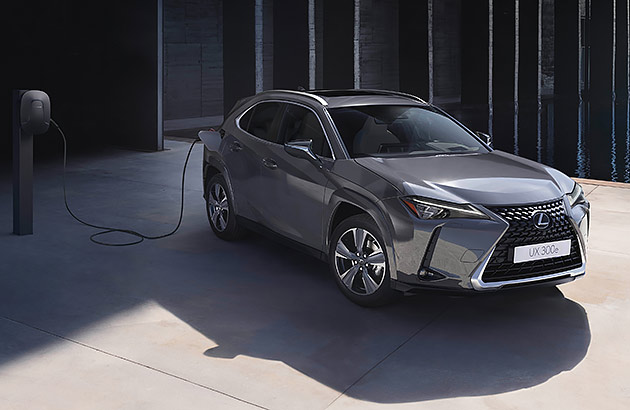
Aimed at the Mercedes EQA and Volvo XC40 Recharge, the UX 300e is the electrified version of Lexus’ small SUV/crossover that’s also available as a petrol and petrol-hybrid.
Replacing the previous 54.4kWh battery version, the updated 72.8kWh model sees range leap from 315km to 440km. But then so has the price.
That bigger battery extends charge times. Roughly speaking, to go from 10-80 per cent using a 50kW DC public charger, you’ll need around 80 minutes, about 12 hours to 100 per cent with an optional 7kW Wallbox and about 40 hours plugged in a normal household socket.
Another change for 2024 is an updated cabin with a larger touchscreen, while the body has been made stronger to improve steering, handling and ride qualities, according to Lexus. There’s also improved safety.
While not big on back-seat or boot space, the UX 300e is a sumptuous, enjoyable and high-quality compact luxury EV from Japan.
| Motor: | Synchronous electric permanent-magnet |
|---|---|
| Transmission/drive: | Single-speed reduction gear/FWD |
| Battery: | 72.8kWh Lithium Ion |
| Power/torque: | 150kW/300Nm |
| 0-100km/h: | 7.5s |
| Consumption: | 17.0 kWh/100km (estimated) |
| Electric range: | 440km |
| Warranty: | 5yr/unlimited km |
| Battery warranty: | 10yr/1,000,000km |
| Safety rating: | 5 stars |
Mercedes-Benz EQA from $81,700
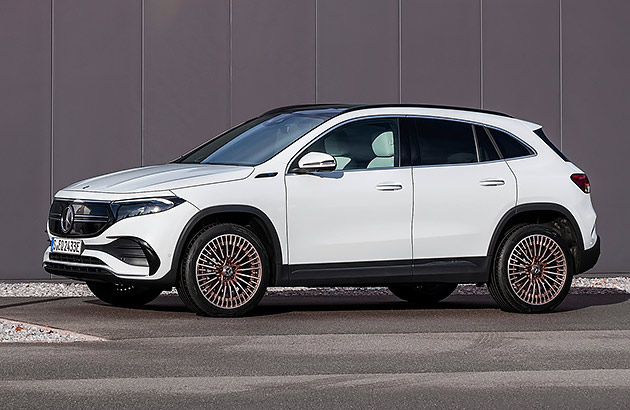
The EQA is a premium, small SUV based on the hugely-popular petrol-powered GLA.
The EQA250 FWD’s 140kW single motor offers modest performance, but is tuned for maximum efficiency. Range is rated at 426km. The speedier EQA350 4Matic version uses two motors (one at each axle) for a combined 215kW and all-wheel drive.
Fitted with a 66.5kWh battery, a 50kW DC public charger can replenish it to 80 per cent in 65 minutes, or 11 hours to 100 per cent with an optional 7kW Wallbox at home/work.
The EQA pretty much lifts the GLA’s 10.25-inch touchscreen dashboard, and that’s no bad thing. Cabin space is reasonable, but the 340-litre cargo capacity is substantially below many rivals. And there’s no additional boot space where the petrol/diesel engines once were.
Standard EQA250 items include adaptive damping and a dynamic steering mode, promoting best-possible ride and handling characteristics.
| Motor: | Synchronous electric permanent-magnet |
|---|---|
| Transmission/drive: | Single-speed reduction gear/FWD |
| Battery: | 66.5kWh Lithium Ion |
| Power/torque: | 140kW/375Nm and 215kW/520Nm |
| 0-100km/h: | 8.9s/6.0s |
| Consumption: | 15.2-17.5 kWh/100km |
| Electric range: | 426km/432km |
| Warranty: | 5yr/unlimited km |
| Battery warranty: | 8yr/160,000km |
| Safety rating: | 5 stars |
BMW iX1 from $84,900
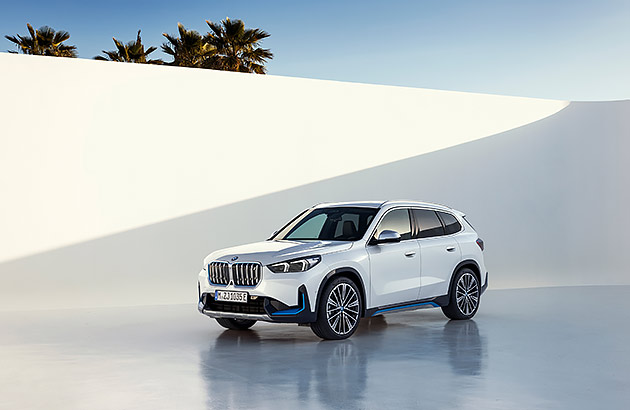
The flagship version of BMW’s third-generation X1, the iX1’s pricing is as sharp as its looks.
With superior fast charging capability and twin-motor all-wheel drive performance standard in the 2023 230kW/494Nm xDrive30 grade, the German midsized SUV has caught competitors like Mercedes’ EQB on the hop.
There’s a 65kWh battery pack for a 440km range. Using a 50kW DC charger, a 10 to 80 per cent recharge needs about 65 minutes, 12 hours with a 7kW garage Wallbox or around 35 hours with a home/garage socket. Each iX1 includes a three-year subscription with Chargefox.
To improve interior space efficiency as well as retain brand performance expectations, BMW says the iX1 employs a new flexible architecture that allows for larger battery packs to be placed lower down.
Equipment levels include adaptive suspension to provide both comfort and controlled handling, a full suite of safety systems, a sunroof and powered tailgate.
| Motor: | Synchronous electric permanent-magnet |
|---|---|
| Transmission/drive: | Single-speed reduction gear/AWD |
| Battery: | 65kWh Lithium Ion |
| Power/torque: | 230kW/494Nm |
| 0-100km/h: | 5.6s |
| Consumption: | 18.4kWh/100km |
| Electric range: | 438km |
| Warranty: | 5yr/unlimited km |
| Battery warranty: | 8yr/160,000km |
| Safety rating: | N/A |
MID-SIZE SUVs
Tesla Model Y from $65,400
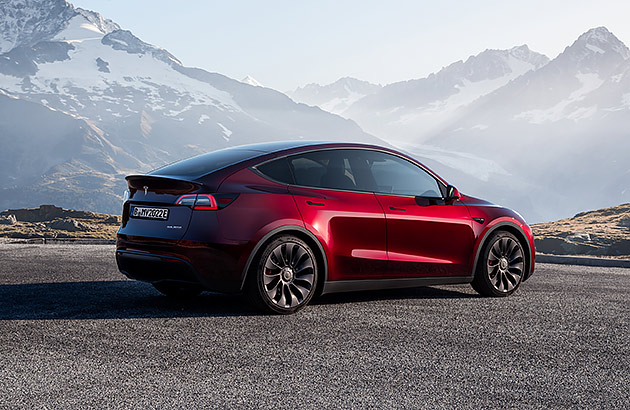
Based on the Model 3 sedan, the newer Model Y is longer, taller and wider, with extra ground clearance and more-family-friendly packaging, complete with a tailgate. Yep, it’s the SUV version.
The Rear-Wheel Drive (RWD) with a single motor and 60kWh battery is the base grade, followed by the Long Range and Performance flagship. Both add dual motors for all-wheel drive (AWD) and an 80kWh battery.
For the AWD Ys, Tesla’s powerful Supercharger Network can provide hundreds of kilometres of range in around 30 minutes, a 50kW DC public charger needs 75mins to go from 10-80 per cent full, or otherwise for a 100 per cent charge you’ll require about 12 hours with an optional 7kW Wallbox, or nearly 40 hours plugged in at home/work. The RWD needs about one-quarter less time to replenish.
The Model Y adopts the minimalist single-tablet dash look inside, but with greater space for five adults and deeper windows for an airier feel than the 3. That’s why it's already a bestseller.
| Motor: | Synchronous electric permanent-magnet |
|---|---|
| Transmission/drive: | Single-speed reduction gear/RWD or AWD |
| Battery: | 60kWh Lithium Iron Phosphate (LFP) – RWD 80kWh Nickel-manganese-cobalt (NMC) – AWD |
| Power/torque: | 194kW/340Nm, 378kW/493Nm, 413kW/660Nm |
| 0-100km/h: | 6.9s, 5.0s, 3.7s |
| Consumption: | 15.7, 16.9, 17.1kWh/100km |
| Electric range: | 455km, 533km, 514km |
| Warranty: | 4yr/80,000km |
| Battery warranty: | 8yr/160,000km |
| Safety rating: | 5 stars |
Hyundai Ioniq 5 from $72,000
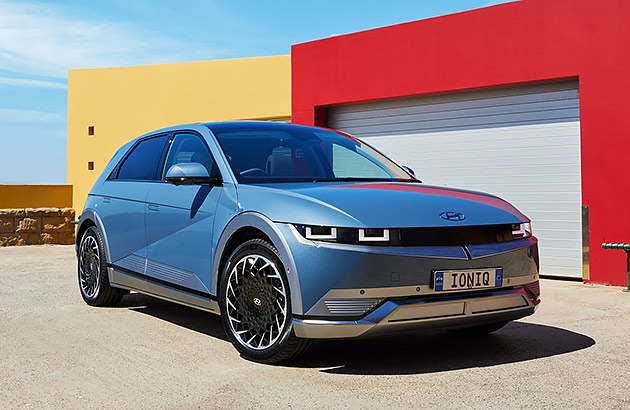
The Ioniq 5 is already a global EV superstar. And its excellence is rooted in the advanced E-GMP dedicated EV architecture as per the Kia EV6 and Genesis GV60.
Available in rear-mounted 168kW single motor/rear-drive or 239kW dual-motor all-wheel drive permutations, the Hyundai features a 77.4kWh battery pack dubbed Long Range.
The Ioniq 5’s 800V electrical set-up means battery charging from 10 to 80 per cent needs around 65 minutes using a 50kW fast charger. Otherwise, it’s about 12 hours to 100 per cent using an optional 7kW Wallbox at home/work, to avoid the nearly 40 hours plugged into a regular wall socket.
An optional roof-mounted solar panel can add a small amount of charge to the battery when the sun's shining.
About the size of a Toyota RAV4, this quasi-SUV EV brings a spacious, versatile and highly-modern interior to match the striking exterior design, as well as a huge 531-litre cargo capacity – with more available in the front boot. Many of the materials inside are recycled.
Finally, advanced driver-assist technology makes the Ioniq 5 a safety leader. It also has vehicle-to-load capability to power other electric appliances and can even return power to the grid where available, further cementing Hyundai’s EV leadership.
| Motor: | Synchronous electric permanent-magnet |
|---|---|
| Transmission/drive: | Single-speed reduction gear/RWD or AWD |
| Battery: | 77.4kWh Lithium Ion |
| Power/torque: | 168kW/350Nm (AWD: 239kW/605Nm) |
| 0-100km/h: | 7.3s (AWD: 5.1s) |
| Consumption: | 17.0kWh/100km (AWD: 17.9) |
| Electric range: | 507km (AWD: 454km) |
| Warranty: | 5yr/unlimited km |
| Battery warranty: | 8yr/160,000km |
| Safety rating: | 5 stars |
Toyota bZ4X from $75,000 (estimated)
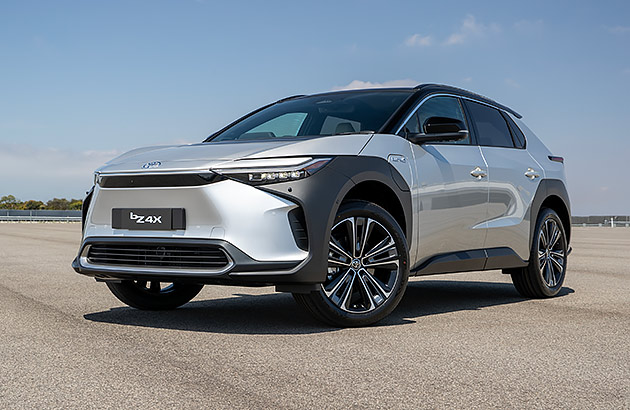
The bZ4X (for ‘Beyond Zero emissions ‘4’ X-over) is Toyota’s first production EV model. It’s been delayed repeatedly for Australia until now.
Very closely related to the Lexus RZ and Subaru Solterra, the RAV4-esque five-seater midsized SUV from Japan features a flat floor to maximise efficiency, creating a spacious, airy and inviting cabin that’s big on high-tech features.
A 150kW motor drives the front wheels, while an 80kW motor on each axle powers the 160kW all-wheel-drive version. The company reckons these outputs are conservative to promote long life and reliability. For now, all grades use a 71.4kWh battery. Typical Toyota.
A 50kW DC fast charger gives a 10 to 80 per cent charge in about 65 minutes. An optional 7kW Wallbox needs about 12 hours to go 100 per cent, or about 33 hours if using a household plug.
Strikingly futuristic yet reassuringly familiar inside, the bZ4X is just the first of many EVs coming from Toyota.
| Motor: | Synchronous electric permanent-magnet |
|---|---|
| Transmission/drive: | Single-speed reduction gear/FWD or AWD |
| Battery: | 71.4kWh Lithium Ion |
| Power/torque: | 150kW/265Nm (AWD: 160kW/336Nm) |
| 0-100km/h: | 7.5 (AWD: 6.9s) |
| Consumption: | 14.4kWh/100km (AWD: 16.2) |
| Electric range: | 516km (AWD: 461km) |
| Warranty: | 5yr/unlimited km |
| Battery warranty: | 10yr/240,000km |
| Safety rating: | 5 stars |
Ford Mustang Mach-E from $79,990
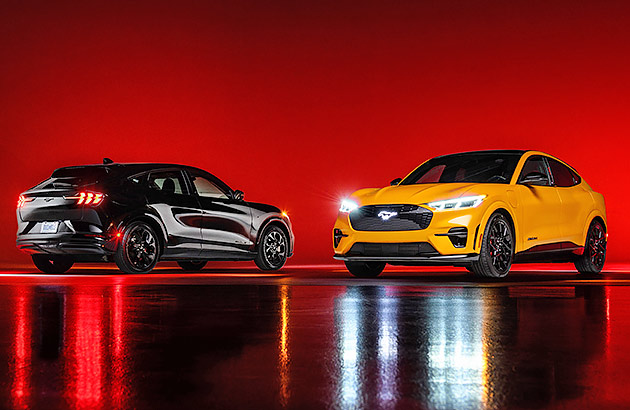
Sharing nothing but evocative styling cues with the Mustang sports car, the Mach-E is a five-door SUV, using an electrified version of the related Escape’s architecture.
Made in Mexico, outputs are: 198kW/430Nm for the base Select rear-drive with a 71kWh battery and 470km range, 216kW/430Nm for Premium rear-drive with a 91kWh battery and 600km range, and 358kW/860Nm and 490km range for the high-performance GT twin-motor all-wheel drive with the same-size battery.
Note the Mach-E has absolutely no off-road capabilities.
Being an SUV means family-friendly packaging, with space for five. The Mach-E is also a step forward for Ford interior design, with a very modern look and feel.
Using a 7kW Wallbox takes 12 hours to recharge the 71kWh battery (91kWh: 15hr), 70 minutes using a 50kW DC outlet (91kWh: 90min), while nearly 40 hours is required with a home plug (91kWh: 50hr).
The Mach-E's retro styling, its stirring performance and great handling round out a unique and emotional EV proposition.
| Motor: | Synchronous electric permanent-magnet |
|---|---|
| Transmission/drive: | Single-speed reduction gear/RWD or AWD |
| Battery: | 71kWh or 91kWh Lithium Iron Phosphate |
| Power/torque: | 198,216,358kW and 430,430,890Nm |
| 0-100km/h: | 3.8-6.1s |
| Consumption: | 16.5-19.5kWh/100km |
| Electric range: | 470-600km (WLTP) |
| Warranty: | 5yr/unlimited km |
| Battery warranty: | 8yr/160,000km |
| Safety rating: | 5 stars |
Subaru Solterra from $80,000 (estimated)
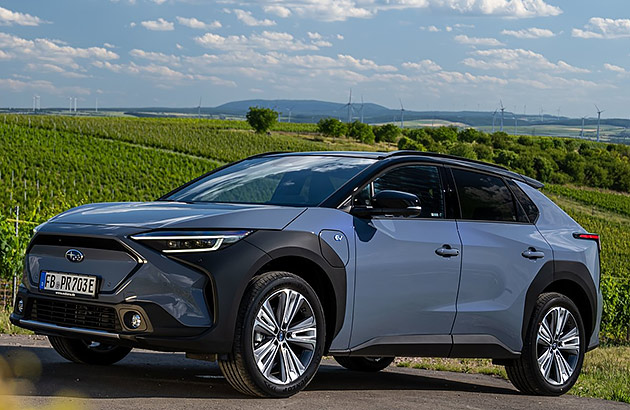
More than merely a badge-engineered version of the Toyota bZ4X, the Subaru Solterra is Subaru’s first EV for Australia.
Aimed at the Kia EV6 and Hyundai Ioniq 5, it is a midsized SUV with five seats and plenty of multimedia and driver-assist safety tech to help justify its lofty pricing. The boot is also family-sized, underlining the EV’s sensible packaging.
Australian-bound models feature an 80kW motor on each axle for all-wheel drive, resulting in a 160kW power maximum, while a 71.4kWh battery offers a range of 460km.
One big difference between the Toyota and Subaru EVs is the latter’s emphasis on lifestyle adventure and (limited) off-road capability, with extra body cladding and noticeably greater ground clearance – 210mm vs 177mm.
A 50kW outlet needs about 65 minutes to go from 10 to 80 per cent full, while an optional 7kW Wallbox requires approximately 12 hours compared to about 33 hours using the normal mains to reach maximum charge.
| Motor: | Synchronous electric permanent-magnet |
|---|---|
| Transmission/drive: | Single-speed reduction gear/AWD |
| Battery: | 71.4kWh Lithium Ion |
| Power/torque: | 160kW/336Nm |
| 0-100km/h: | 6.9s |
| Consumption: | 16.0kWh/100km |
| Electric range: | 460km |
| Warranty: | 5yr/unlimited km |
| Battery warranty: | 8yr/160,000km |
| Safety rating: | 5 stars |
Mercedes-Benz EQB from $87,800
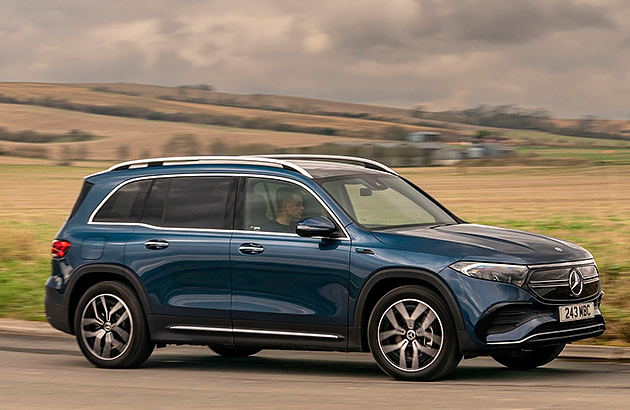
Mercedes-Benz’s big-selling GLB seven-seater midsized SUV goes electric with the EQB.
Joining the related smaller EQA, the EQB offers two grades: the EQB250 and EQB350 4Matic.
You’ll spot it from the usual blanked-out grille and unique headlight and wheel treatments, as well as a redesigned tailgate with the EQ-signature horizontal LED tail-light motif.
The EQB250 drives only the front wheels via a front-mounted 140kW electric motor while the EQB350 4Matic leverages a dual-motor configuration, thanks to the addition of a rear-mounted electric motor, for all-wheel drive. Total system power output is 215kW.
A 50kW DC public fast-charger will fill the sizeable 66.5kWh battery from 10 to 80 per cent in around 70 minutes, or 11 hours to 100 per cent with an optional 7kW Wallbox.
Packaging-wise, the EQB brings full five-seater space plus two occasional seats in the 250 FWD. The middle row slides to vary the amount of cargo space on offer, further upping the Benz’s practicality.| Motor: | Synchronous electric permanent-magnet |
|---|---|
| Transmission/drive: | Single-speed reduction gear/AWD |
| Battery: | 66.5kWh Lithium Ion |
| Power/torque: | 140kW/385Nm (350 AWD: 215kW/520Nm) |
| 0-100km/h: | 9.2s (350 AWD: 6.2s) |
| Consumption: | 16.5kWh/100km (350 AWD: 18.4) |
| Electric range: | 474km (350 AWD: 416km) |
| Warranty: | 5yr/unlimited km |
| Battery warranty: | 8yr/160,000km |
| Safety rating: | 5 stars |
BMW iX3 from $104,900
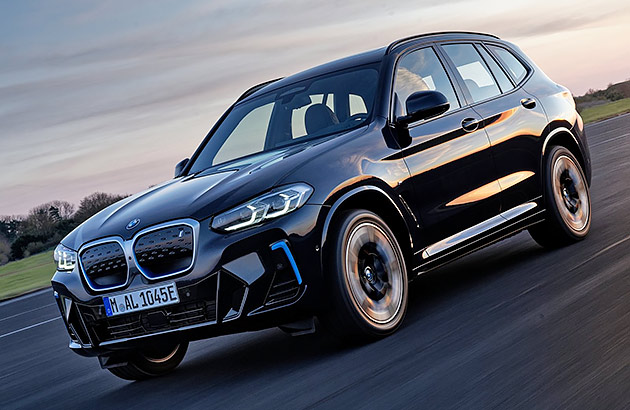
An electrified version of the popular X3 medium-sized SUV, the iX3 uses BMW’s fifth-gen eDrive technology, so it doesn’t sit on a dedicated EV architecture like the newer iX.
Still, with a 210kW/400Nm electric motor to drive the rear wheels only, it brings both spirited performance (0-100km/h needs just 6.8 seconds) and impressive efficiency.
Conversely, up to 460km of range is promised from an underfloor-sited 80kWh battery, with regenerative braking technology harnessing otherwise spent energy to help recharge while on the move.
If you find a 50kW DC public fast charger, the iX3’s battery pack can be replenished from 10 to 80 per cent in about 75 minutes – or else the optional 7kW or 11kW Wallbox need 12 or eight hours respectively.
Otherwise, the iX3 is as-per the existing X3, boasting a spacious and practical interior with ample room for five occupants, as well as high quality materials.
BMW’s latest OS 7.0 multimedia system is fitted, capable of over-the-air updates. A special technology pipes in changeable ‘driving manoeuvres’ sounds through the audio system. Passenger comfort benefits from adaptive dampers that prioritise softness.
The iX3 is also the first BMW sold in Australia to be built in China.
| Motor: | Synchronous electric permanent-magnet |
|---|---|
| Transmission/drive: | Single-speed reduction gear/RWD |
| Battery: | 80kWh Lithium Ion |
| Power/torque: | 210kW/400Nm |
| 0-100km/h: | 6.8s |
| Consumption: | 18.5kWh/100km |
| Electric range: | 460km |
| Warranty: | 3yr/unlimited km |
| Battery warranty: | 8yr/160,000km |
| Safety rating: | 5 stars |
Genesis GV60 from $107,700
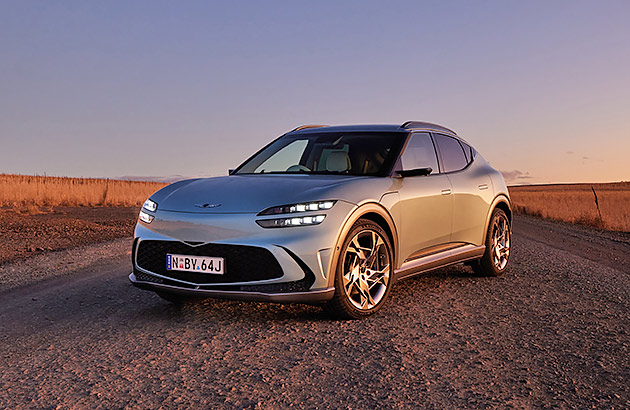
Related to the Hyundai Ioniq 5 and Kia EV6, the stylish and striking Genesis GV60 midsized luxury SUV is chasing BMW iX1 and Tesla Model Y buyers.
Two powertrain choices exist – a 234kW dual-motor all-wheel and 320kW AWD Sports version, the latter offering a 360kW overboost function for extra thrust. Both feature a 77.4kWh battery, with a WLTP range of 400km and 368km respectively.
A 50kW DC charger needs only 65 minutes to go from 10-80 per cent, an optional 7kW Wallbox at home/work reaches 100 per cent in 12 hours, while a regular household outlet needs nearly 40 hours. ‘Vehicle to Load’ (V2L) capability allows the Genesis to act like a big-appliance generator.
Other standout tech features include video side mirrors, facial recognition entry and fingerprint reader gear-shift release.
Factor in value pricing, lots of equipment and plenty of safety tech, and it’s clear Genesis is serious about leading the luxury EV SUV pack.
| Motor: | Synchronous electric permanent-magnet |
|---|---|
| Transmission/drive: | Single-speed reduction gear/AWD |
| Battery: | 77.4kWh Lithium Ion |
| Power/torque: | 234/360kW and 605/700Nm |
| 0-100km/h: | 5.2/4.0 s |
| Consumption: | 19.3/20.1kWh/100km |
| Electric range: | 400/368km |
| Warranty: | 5yr/unlimited km |
| Battery warranty: | 8yr/160,000km |
| Safety rating: | 5 stars |
Lexus RZ from $123,000
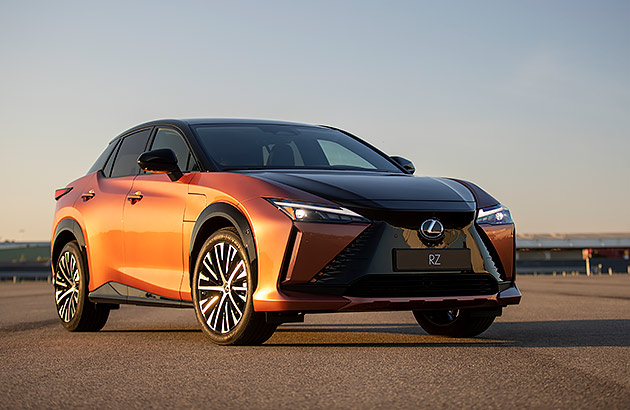
Lexus’ second all-electric vehicle, the RZ, is a medium-sized luxury SUV that’s closely related to the Toyota bZ4X.
One model is here for now – the RZ 450e – in Sport and Sport Luxury grades.
Built on an electrified variation of the Toyota New Global Architecture, there’s an electric motor on each axle for all-wheel drive, with maximum power of 230kW, and a 71.4kWh lithium-ion battery stored in between.
With a very-Lexus look inside and out, there’s nothing unfamiliar about the RZ – except for its available steering yoke – a steer-by-wire technology that cuts steering turns by two-thirds. Even the tightest U-turn requires barely over half a circle.
Find a 50kW DC charger, and the RZ can be charged from 10-80 per cent in under 70 minutes, or to 100 per cent in 12 hours using an optional 7kW Wallbox. A household plug needs about 33 hours or so.
Rivals include the BMW iX and Mercedes EQC.
| Motor: | Synchronous electric permanent-magnet |
|---|---|
| Transmission/drive: | Single-speed reduction gear/AWD |
| Battery: | 77.4kWh Lithium Ion |
| Power/torque: | 230kW/435Nm |
| 0-100km/h: | 5.6s |
| Consumption: | 20.0kWh/100km (estimated) |
| Electric range: | 470km |
| Warranty: | 5yr/unlimited km |
| Battery warranty: | 8yr/160,000km |
| Safety rating: | N/A |
Genesis Electrified GV70 from $127,800
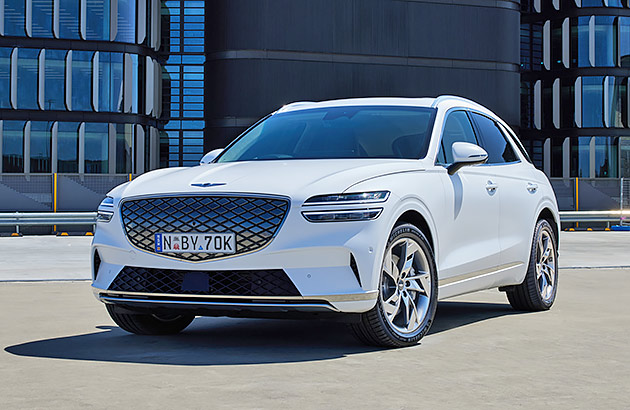
Also known as the eGV70, the Electrified GV70 is Hyundai luxury brand Genesis’ take on the Mercedes-Benz EQC and BMW iX.
Like its German rivals, this is an electrified version of an internal combustion engined vehicle.
A single powertrain choice is offered for now, with a 160kW motor at each end, though a brief overboost feature pushes the combined maximum output up to 360kW.
An 800-volt charging capability means a 350kW rapid charger will top the battery up from 10 to 80 per cent in under 20 minutes. Using a 50kW DC charger, the GV70 needs about 70 minutes for a 10 to 80 per cent top-up, or about 12 hours to 100 per cent with an optional 7kW Wallbox. Plugging in at home will take nearly 40 hours.
Plus, a V2L function allows for electrical appliances to be powered outside the vehicle.
Finally, some mild off-road capability is possible.
| Motor: | Synchronous electric permanent-magnet |
|---|---|
| Transmission/drive: | Single-speed reduction gear/AWD |
| Battery: | 77.4kWh Lithium Ion |
| Power/torque: | 320kW/700Nm (360kW on overboost) |
| 0-100km/h: | 4.2s |
| Consumption: | 19.2kWh/100km |
| Electric range: | 455km |
| Warranty: | 5yr/unlimited km |
| Battery warranty: | 8yr/160,000km |
| Safety rating: | 5 stars |
Mercedes-Benz EQC from $128,000
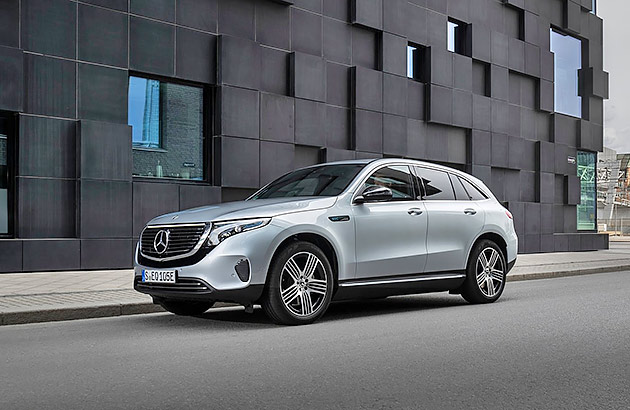
Surprisingly Mercedes’ first EV in Australia, the EQC is based on the GLC medium SUV, but shares no body or interior panels.
Designed to be highly user-friendly, it seats five people comfortably, boasts a large cargo area and is packed with equipment, backed up by a full array of driver-assist safety.
With a combined 300kW from two electric motors for all-wheel drive, the EQC400 4Matic is a strong performer. Another highlight is impressive refinement with the available air suspension.
Fitted with an 80kWh battery pack, the German EV charges from 10 to 80 per cent in 75 minutes using a 50kW DC public fast charger. Otherwise, 100 per cent full using an optional 7kW Wallbox at home/work needs 13 hours, to avoid 41-hours plugged into a regular wall socket.
The EQC is an exceptionally easy and comfortable first EV effort for Mercedes. Expensive options aside, there’s much to recommend.
| Motor: | Synchronous electric permanent-magnet |
|---|---|
| Transmission/drive: | Single-speed reduction gear/AWD |
| Battery: | 80kWh Lithium Ion |
| Power/torque: | 300kW/760Nm |
| 0-100km/h: | 5.1s |
| Consumption: | 22.3kWh/100km |
| Electric range: | 417km |
| Warranty: | 5yr/unlimited km |
| Battery warranty: | 8yr/160,000km |
| Safety rating: | 5 stars |
Mercedes-Benz EQE SUV from about $150,000 (estimated)
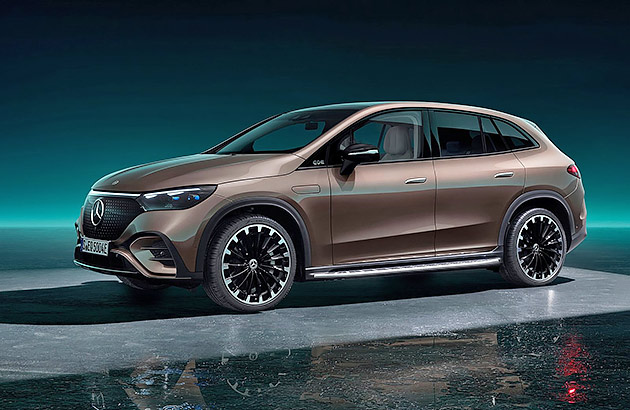
A high-riding wagon, the EQE SUV sits on the same advanced EVA architecture as the sedan, and slots above the older EQC but under the EQS.
At launch later in 2023, expect the rear-axle-mounted single-motor rear-drive 350, the 500 4Matic with a front motor added for all-wheel drive and AMG versions, topped by the EQE53 4Matic+. All use a 90.6kWh lithium-ion battery.
The EQE SUV’s dash is striking and high-tech, with few actual buttons and an advanced ‘Hey, Mercedes’ voice command system. Options will include a vast ‘Hyperscreen’ dash with a trio of segmented displays, air suspension with adaptive dampers and four-wheel steering, to aid agility.
As with the sedan, the SUV plugged into a 50kW DC charger needs about 80 minutes for the battery to go from 10 to 80 per cent. With the included 7kW Wallbox that’s around 15 hours, or under 50 hours using a regular socket.
This should be one of Mercedes’ bestselling EVs.
| Motor: | Synchronous electric permanent-magnet |
|---|---|
| Transmission/drive: | Single-speed reduction gear/RWD or AWD |
| Battery: | 90.6kWh Lithium Ion |
| Power/torque: | 215kW/565Nm, 300kW/858Nm, 460kW/1000Nm |
| 0-100km/h: | 7.0s, 5.0s, 3.5s |
| Consumption: | 17.7, 19.0, 22.6kWh/100km |
| Electric range: | 590km, 547km, 488km |
| Warranty: | 5yr/unlimited km |
| Battery warranty: | 8yr/160,000km |
| Safety rating: | 5 stars |
LARGE SUVs
Kia EV6 from $72,590
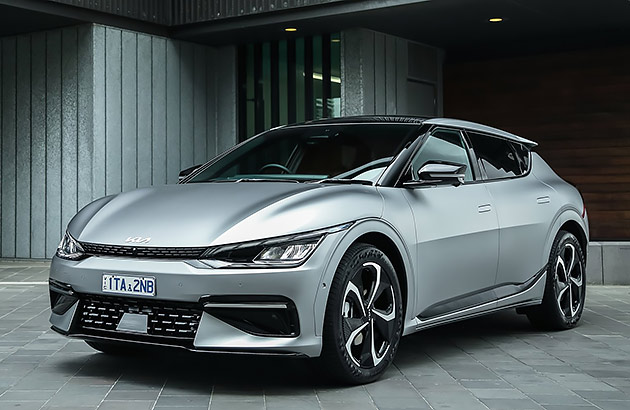
Kia’s swoopy EV6 employs the same 800-volt e-GMP electric architecture as the Hyundai Ioniq 5.
Along with its own body and interior, it also benefits from a unique Australian handling and ride tune.
Using an updated 77.4kWh battery, the EV6 Long Range comes in either a rear-mounted 168kW electric motor rear-drive model, or 74kW-front/165kW-rear 239kW dual-motor all-wheel drive guise.
There’s also a GT, Kia’s fastest, most powerful and most expensive car ever in Australia, with 430kW and 3.5 seconds from 0-100km/h.
Recharging from 10 to 80 per cent using a 50kW DC public fast charger needs 65 minutes. Otherwise, 100 per cent full using an optional 7kW Wallbox at home/work takes 12 hours respectively, to avoid a 38-hour wait plugged into a regular wall socket.
The EV6’s cabin looks premium, and is dominated by huge touchscreen designs incorporating multimedia and instrumentation.
Factor in ample space, generous equipment levels and leading safety, and Kia’s EV6 is a real game-changer.
| Motor: | Synchronous electric permanent-magnet |
|---|---|
| Transmission/drive: | Single-speed reduction gear/RWD or AWD |
| Battery: | 77.4kWh Lithium Ion |
| Power/torque: | 168kW/350Nm, 239kW/605Nm, 430kW/740Nm |
| 0-100km/h: | 7.3s/5.2s/3.5s |
| Consumption: | 16.5, 17.2, 20.6 kWh/100km |
| Electric range: | 528km, 400km, 370km |
| Warranty: | 7yr/unlimited km |
| Battery warranty: | 8yr/160,000km |
| Safety rating: | 5 stars |
Kia EV9 from $100,000 (estimated)
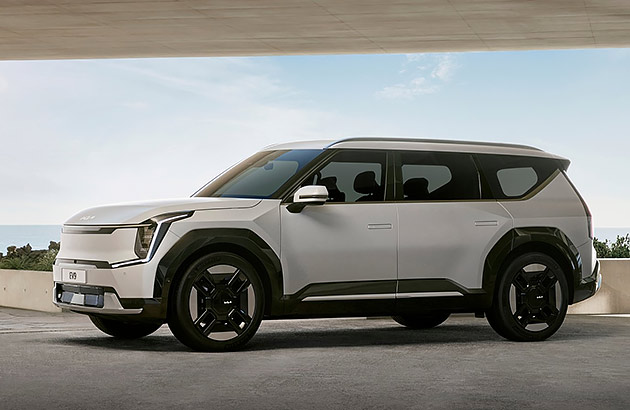
Due at the end of 2023, the Kia EV9 will target the likes of the Mazda CX-90 and Volvo XC90, and features Hyundai/Kia’s lauded E-GMP 800-volt architecture with ultra-fast charging capability.
There are two battery versions, starting with a 76.1kWh pack in the Standard Range with rear-wheel drive (RWD), using a 160kW/350Nm electric motor.
The Long Range RWD adopts a 99.8kWh battery, and is claimed to offer nearly 550km, while the EV9 all-wheel drive has a 160kW motor on the rear axle and adds another up front, for a combined 283kW/600Nm.
At over five metres long, the boldly geometric Kia is a full three-row SUV, with expansive space inside thanks to a massive wheelbase. Six or seven-seater configurations will be available.
It’s also the first Kia to abandon leather in the name of sustainability, towing capacity is 2500kg and safety is said to be world-class.
| Motor: | Synchronous electric permanent-magnet |
|---|---|
| Transmission/drive: | Single-speed reduction gear/RWD or AWD |
| Battery: | 76.1 or 99.8kWh Lithium Ion |
| Power/torque: | 160kW/350Nm and 283kW/600Nm |
| 0-100km/h: | 8.2s/5.3s |
| Consumption: | N/A |
| Electric range: | 545km (estimated) |
| Warranty: | 7yr/unlimited km |
| Battery warranty: | 8yr/160,000km |
| Safety rating: | N/A |
BMW iX from $130,900
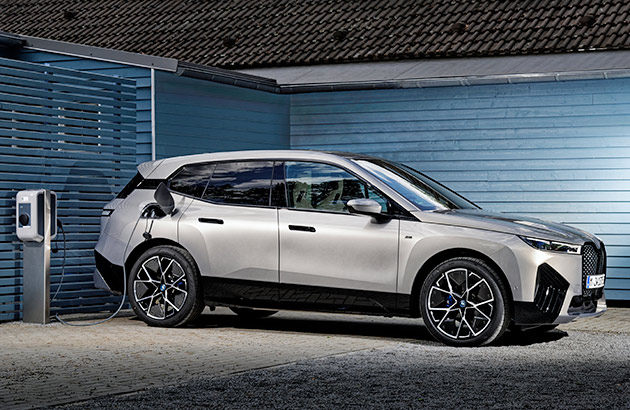
If the BMW iX really represents the future, then we’re here for it.
Currently available in three models – 270kW xDrive40, 370kW xDrive50 and 455kW M60 – the large SUV is the Bavarian brand’s electrified SUV flagship for now.
Ushering in BMW’s fifth-generation eDrive drivetrain with an electric motor on each axle and aided by excellent aerodynamics, the iX is quick by any standards.
The 40 is fitted with a big 77kWh battery, while the 50 and M60 boast a mammoth 111kWh battery.
A 50kW DC public fast charger will take the 50’s battery from 10 to 80 per cent in 95 minutes. Otherwise, it’s about 17 hours using an optional 7kW Wallbox at home/work respectively, to avoid nearly two days plugged into a regular wall socket – yes, two days. The 40’s times should be about 40 per cent shorter.
The iX employs a lightweight aluminium spaceframe and a carbon-fibre ‘safety cage’, assisting efficiency whilst making it ultra-strong. The optional air suspension also brings an amazingly soft ride. To maximise cabin space, the iX banishes the central transmission tunnel.
BMW is at the top of the EV game.
| Motor: | Synchronous electric permanent-magnet |
|---|---|
| Transmission/drive: | Single-speed reduction gear/AWD |
| Battery: | 77kWh or 111kWh Lithium Ion |
| Power/torque: | 240kW/630Nm, 385kW/765Nm, 455kW/1100Nm |
| 0-100km/h: | 6.1, 4.6, 3.8s |
| Consumption: | 20.3, 20.8, 21.7kWh/100km |
| Electric range: | 425, 630, 566km |
| Warranty: | 3yr/unlimited km |
| Battery warranty: | 8yr/160,000km |
| Safety rating: | 5 stars |
Jaguar I-Pace from $148,800
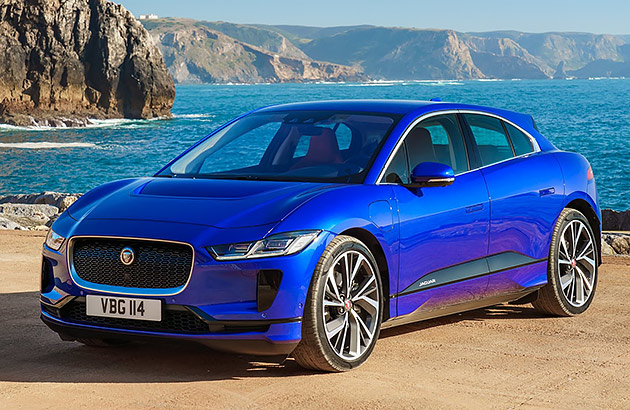
If the I-Pace cannot shake Jaguar’s pipes-and-slippers reputation, nothing can.
A bolt from the blue, the Austrian-built I-Pace is a sleek five-seater crossover sitting on a dedicated EV platform.
Its family-orientated SUV packaging results in ample space for five adults, sumptuous seating and a massive boot beneath, while the high-tech, elegantly-styled dash features intuitive controls, tactile materials and plenty of storage.
In 2023 a raft of minor updates and improvements were introduced.
With an electric motor at each end driving all four wheels, acceleration is startling, accompanied by a turbine whoosh. With AWD, carving up corners quickly and securely is another I-Pace strength, emphasising the Jaguar’s high-speed balance and control.
The 90kWh battery pack needs 44 hours using a normal home socket or nearly 14 hours using an optional 7kW Wallbox at home/work. Otherwise, a 50kW DC public fast charger requires just 75 minutes for a 10 to 80 per cent top-up.
| Motor: | Synchronous electric permanent-magnet |
|---|---|
| Transmission/drive: | Single-speed reduction gear/AWD |
| Battery: | 90kWh Lithium Ion |
| Power/torque: | 294kW/696Nm |
| 0-100km/h: | 4.8s |
| Consumption: | 22kWh/100km |
| Electric range: | 446km |
| Warranty: | 5yr/unlimited km |
| Battery warranty: | 8yr/160,000km |
| Safety rating: | 5 stars |
Electric range is quoted using the World harmonised Light vehicle Testing Procedure (WLTP), or otherwise are manufacturers’ claims.
Considering an EV? Get a discount on your car loan interest rate.
Get 0.50% p.a. off your car loan interest rate when you buy an electric vehicle.
T&Cs: Discount applies to fully electric new and used vehicles, excludes Hybrid vehicles. Offer is subject to RAC Finance Lending Terms and Conditions. Fees and charges apply. Australian Credit Licence 387972.
